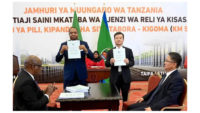Transportation
Chinese Contractor Awarded $1.2B Zambia Road Project
321-km carriageway is the biggest infrastructure project in the landlocked country’s history
Chinese contractor China Jiangxi Corp. for International Economic & Technical Corp. has won a $1.2-billion road-construction deal in Zambia, the biggest infrastructure project in the landlocked country's history. CJIC will finance, design and construct the 321-kilometer, two-lane highway that will link Lusaka, Zambia's capital, to Ndola, the city of the country's copper-belt region.
The contract will take 48 months to complete, according to Zambia's state-owned road-sector operator Road Development Agency (RDA). The road also will link Zambia with its mineral-rich neighbor, the Democratic Republic of Congo (DRC). Zambia, Africa's second-biggest copper producer, hopes to use the expanded road to decongest heavy traffic to its copper-belt region and ease the flow of exports and imports to and from DRC.
The road is part of the 2,500-km-long Walvis Bay-Ndola-Lubumbashi Development corridor, linking the Namibian port of Walvis Bay with Zambia, the southern part of DRC and Zimbabwe. It will be constructed under a build-operate-transfer model.
Although neither RDA nor CJIC provided any details on the road, Zambian President Edgar Lungu on Sept. 7 noted that, when the project broke ground, at least 20% of subcontractors will be Zambian. Further, the project will create 3,000 jobs during construction. "The Lusaka-Ndola dual carriageway will improve the flow of traffic, thereby drastically reducing road accidents," said Lungu.
CJIC also will construct a proposed 45-km gravel road that will branch out to Luanshya from the main Lusaka-Ndola highway at Kafulafuta, which is about 49.2 km from Ndola, according to RDA.
The 321-km, two-lane highway will consist of 50-millimeter-thick asphalt-concrete on a 200-mm crushed-stone base and a 300-mm cement-stabilized sub-base, according to a previous RDA project brief. The two lanes will be 6.8 m wide, with 2-m-wide shoulders and grade separation where required, the project brief shows.
In the rural sections of the road, a median separation will be 9.2 meters wide; in urban areas, it will be only 2 m wide. Also in urban areas, CJIC will construct service lanes on either side of the road, including facilities to accommodate pedestrian traffic, such as walkways, cycle lanes and walk-over bridges.
Two bypasses have been proposed around Kabwe and Kapiri Mposhi, two towns that are on the project route about 143 km and 200 km, respectively, from Lusaka.
RDA also has selected portions of the existing road for either rehabilitation or reconstruction, with 2-m-wide shoulders.
RDA proposes to toll the Lusaka-Ndola road. Expected to construct toll plazas at the designated toll sites, CJIC also will submit a proposal to the Zambian government on how long a concessionaire is to operate the road.

